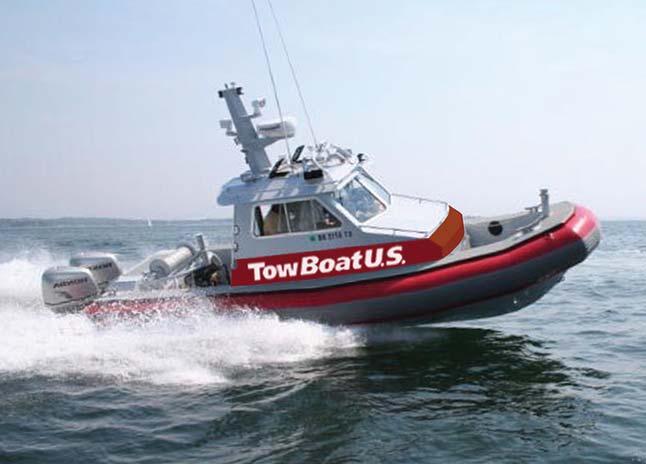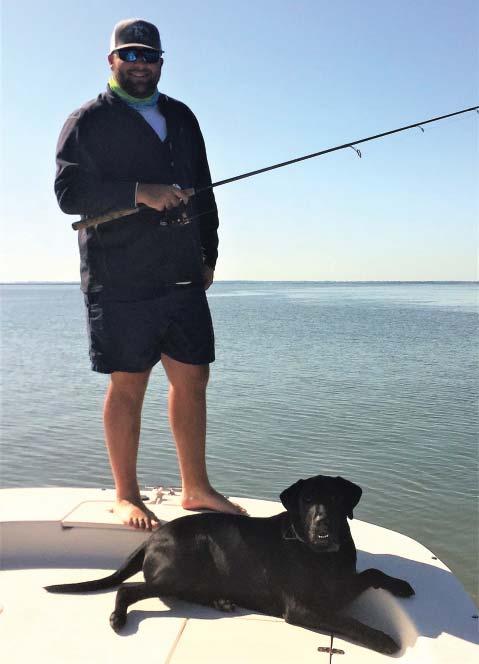
20 minute read
9 Ebb & Flow
Hot! Hot! Hot!
By Trey Leggett
Advertisement
We have defi nitely made it to summer here in the Southeast! As usual, we have high temperatures, high humidity, mosquitoes, and unpredictable pop-up thunderstorms – all typical conditions for residents of this area, but worth bringing up in case you’ve become complacent from our nice spring weather.
My son and I went fi shing/scouting the other day. The winds were light and out of the west, which made for a very calm day on the water. The temperature was tolerable when we set out, but it was climbing. Boats were gathering at inlet beach areas to enjoy a day on the water.
While checking some areas for tripletail, we saw a bonito come straight out of the water, but we weren’t sure if it was a Skipjack or a Little Tunny. We started trolling with lures in that area but had no luck.
We then moved on to troll with lures, beachside, for Spanish mackerel. By this time the sweat beads were forming and we started chugging water. After not getting any hookups we began checking some other areas for mackerel and we stumbled across a large single cobia. We attempted to throw lines at it, but it was on a mission to get somewhere else.
We made our way back inland and tried some inshore fi shing but immediately surmised that it was too stinkin’ hot to fi sh sitting still. On our way back to the boat ramp we continued to hydrate with more cool water.
Yep, a boring story about not catching fi sh! But what was really revealed on that day was: 1) You never know what you might come across out there 2) Whether you’ll have the right tackle to pursue the unexpected 3) Having plenty of cool drinking water is a must 4) Sunscreen, sunscreen, sunscreen 5) It sure would have been nice to have some shade from a T-top or bimini!
Although we aren’t even in the dog days of summer yet, it’s already dangerously hot outside. Make sure to plan and pack necessary items like water, sunscreen, hat, umbrella or some other device for shade. Know the signs and symptoms of heat-related injuries to help protect yourself and others.
Summertime also brings with it an array of unpredictable pop-up thunderstorms. These storms may not last a long time, but can have damaging winds up to 60 mph, hail, and dangerous lightning. Outrunning these storms by boat when they’re close is not advisable. It’s always better to hunker down in a safe place until the storm passes. Also make sure your boat is properly grounded
Trey's son Austin with their pup, Charlie. Photo by Trey Leggett
against lightning.
It’s extremely important that you plan ahead, have communication abilities with the Coast Guard, have a fl oat plan in place, and use good judgement while on the water this summer. It’s going to be hot, but it’s going to be fun!
Stay safe and tight lines!
Trey fi shes for Hobie Polarized Sunglasses, and ENGEL Coolers. Email: info@southerntidesmagazine.com

Located in a Scenic Historic District; Listed on the National Register of Historic Places
The Best of Savannah, Georgia!
Complimentary Loaner Cars
Drive in minutes to local restaurants, grocery stores, West Marine, and a Wal-Mart Supercenter.
Dockside Amenities
• Complimentary High-Speed Wi-fi • 30 - 50 - 100 amp electrical service • 4,000 feet of floating concrete docks • 600 feet of deep water face docks • Gas and diesel facilities • Pump-out station
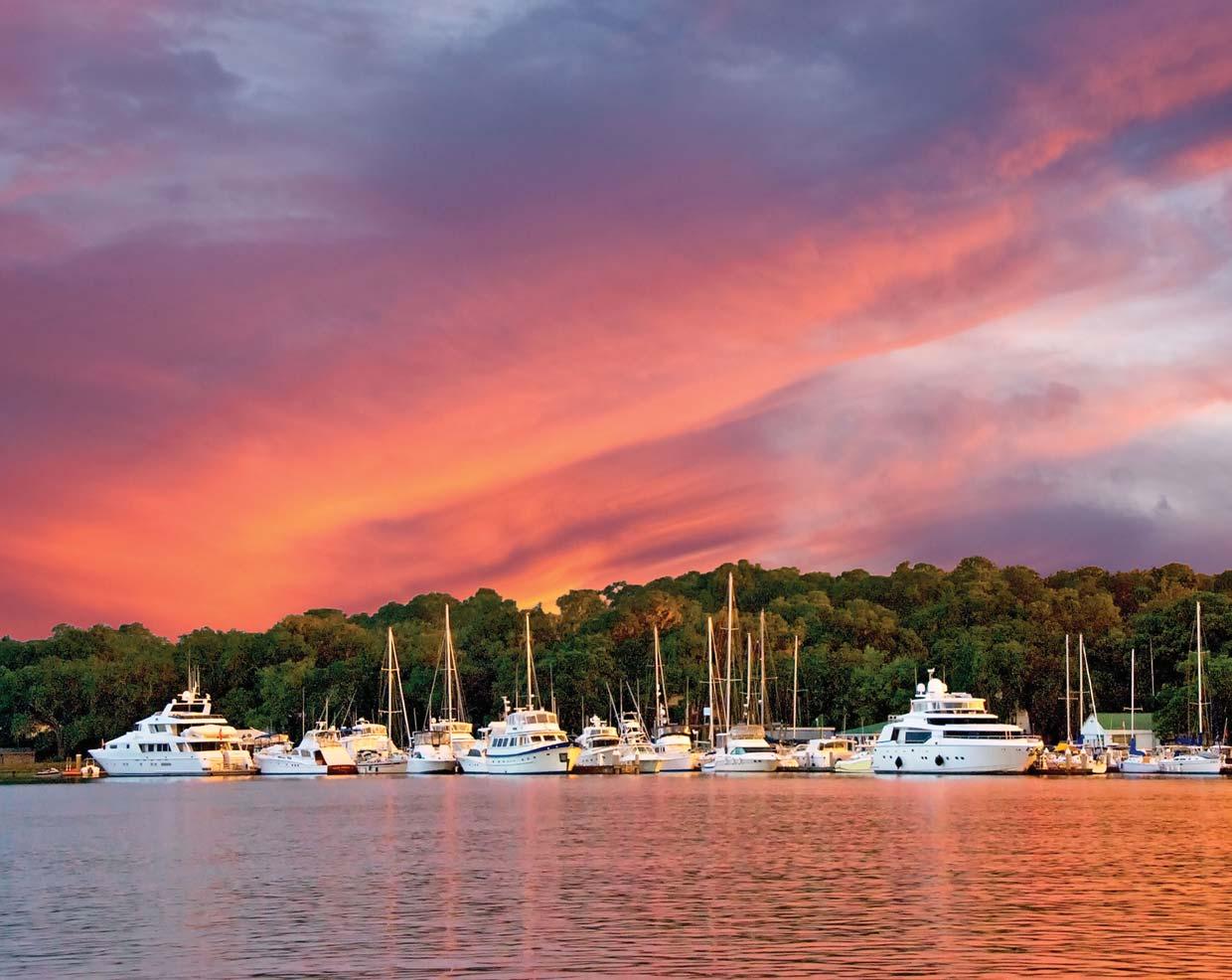
Marina Amenities
• Complimentary loaner cars & bicycles • Ship’s store and laundry facilities • 2,000 sq. ft. overwater pavilion • Private restrooms and showers • Seasonal swimming pool
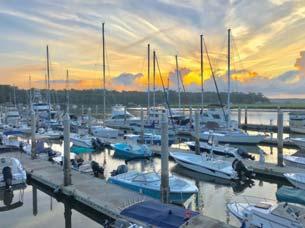

By Stephanie Pedron
Summer is an exciting time for research at Gray’s Reef.
On July 30, crews aboard the NOAA ship Nancy Foster and the R/V Joe Ferguson will embark on a 10-day mission to support Gray’s Reef National Marine Sanctuary staff in conducting their annual research expedition. Professionals hailing from several universities and NOAA divisions will come together to lead a variety of research missions within the sanctuary. Their research and monitoring eff orts aid in advancing understanding of the sanctuary’s unique marine ecosystem. Work at the reef can be challenging due to sea conditions and visibility, but the rewards are mighty and are worth the time spent interacting with Gray’s Reef’s incredibly diverse environment.
Across the sanctuary, scientifi c dive teams will undertake a mix of exciting projects. Some will be scouring the reef for “hotspots” that support endangered species like loggerhead sea turtles. With the current intensive focus on the health of reefs, scientists from two diff erent Georgia universities will be teaming up to develop new ways of safely collecting baby corals in their natural habitat. Other scientists hope to learn more about the performance of acoustics used in fi sh surveys.
An ongoing study that examines the relationship between predatory fi sh and their prey also will be continued. Researchers plan to place 360-degree video cameras underwater to fi lm these fi sh in their natural environment. This project has produced important information about fi sh behavior in Gray’s Reef, and they hope to learn more from these videos. Divers also will be using special breathing gear called, rebreathers, which recycle oxygen. This nifty device allows them to go even deeper into the sea.
There’s no shortage of valuable experiments this year and the Nancy Foster team is eager to implement all of them. But with so many new projects underway, they’ll no doubt have their work cut out for them. An example of one of this year’s bigger tasks involves the lowering of a 1,200 pound concrete platform to the reef’s fl oor. Dr. Scott Noakes, a research scientist from the University of Georgia, will be setting sensors along this platform to monitor the waters for high levels of acid. Nearby, researchers will collect coral fragments for scientifi c experiments. If their work is successful, these corals could be used as natural detectors for change in the level of carbon dioxide at Gray’s Reef, replacing the pricy monitoring equipment used today. They’re just like canaries in a coal mine, warning scientists of potential danger!
While it might seem like a lot to tackle in one trip, these projects will provide Gray’s Reef staff with important information about how to keep the sanctuary vibrant and healthy. Each project strives to be a valuable addition to the growing body of knowledge about Gray’s Reef. With the jam-packed itineraries of the team, it’s not a surprise to learn they’ll be working tirelessly as soon as they leave port; but they do so with the knowledge that they’re helping sustain one of America’s most treasured gems.
Follow this column next month to learn more about the mission. Which project do you think will be your favorite? For more information, email michelle.riley@noaa.gov or call (912) 598-2345
Top: Close-up of anemones. Photo by Greg McFall/NOAA Center: A plumed scorpion fi sh. Photo by Tim Henkel/Valdosta StateUniversity Right: Black sea bass peering out of a vase sponge. Photo by Greg McFall/NOAA
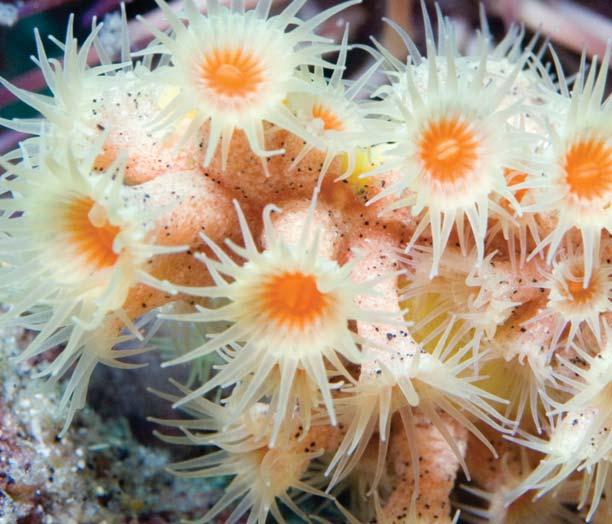
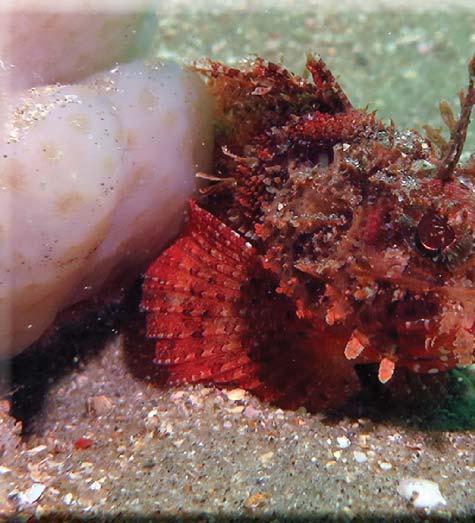
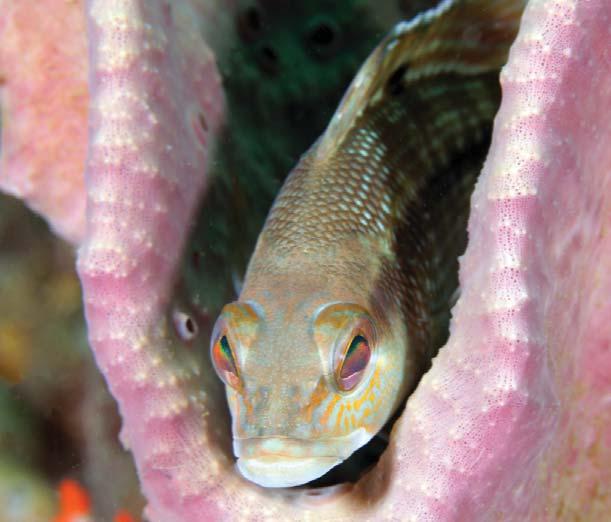
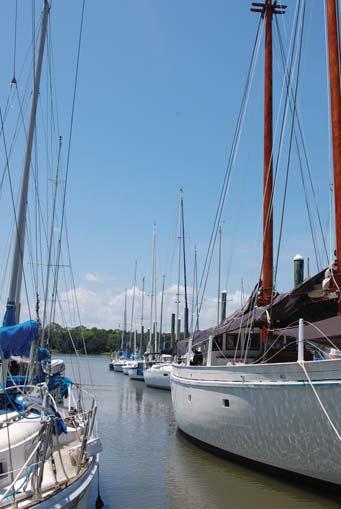
Marina: (912) 897-2896 Boatyard: (912) 897-1914
606 Wilmington Island Road Savannah, GA 31410 www.sailharbormarina.com
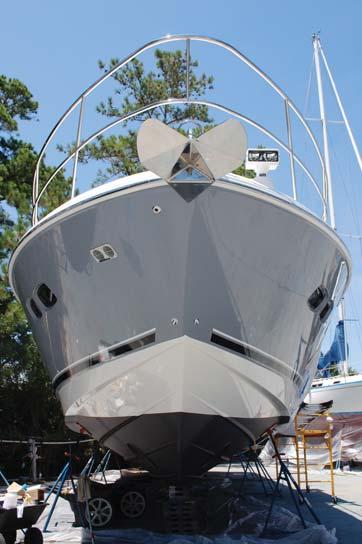
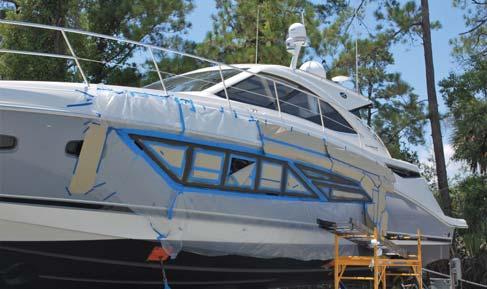
The Boatyard
Air Conditioning Installation/Repair Electronics Installation/Repair Canvas/Sail Repair Emergency 24/7 haul out Complete Painting Services Fiberglass/Blister Repair Prop/Shaft Repair Gas/Diesel Mechanics Sailboat Rigging Services Marina Facilities on Site Deep Water Pickup/Delivery Services Over Land Pickup/Receiving
50 Ton 17-foot Beam Travel Lift
Now allowing DIY bottom prep & painting!
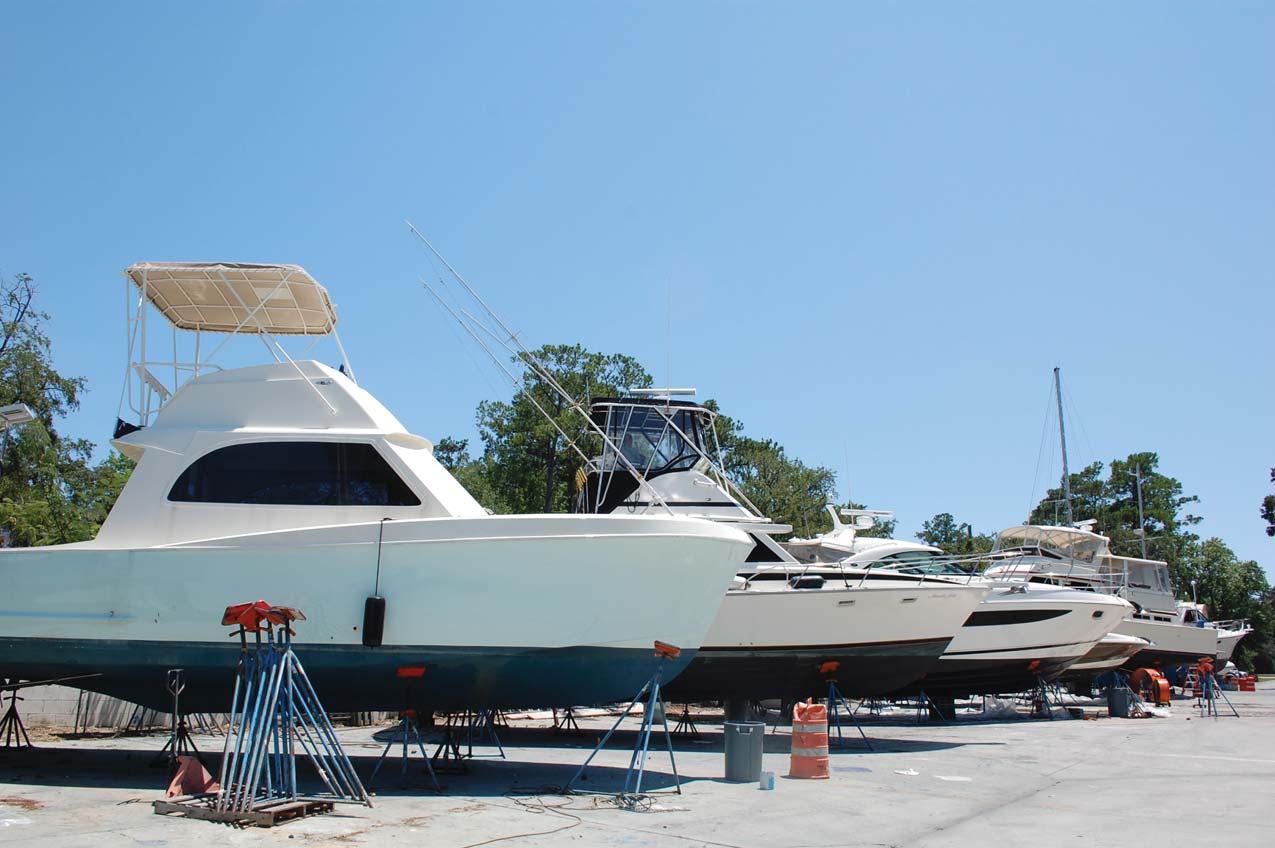
Did You Know? Taste of the Tides
Our coastal sharks have some unique characteristics. Test your knowledge with our shark trivia! Lemon Herb Baked Flounder
Clockwise from top left: Blacknose shark (photo by NOAA); blacktip shark (photo by fi shx6 via Wikimedia); bonnethead shark (photo by D. Ross Robertson/ Smithsonian); fi netooth shark jaw (photo by D. Ross Robertson/Smithsonian); scalloped hammerhead (photo by Kevin Lino/NOAA); sharpnose shark (photo by Amy Thurman).
• Blacknose Sharks (Carcharhinus acronotus) Some of the females of this species reproduce every year and some reproduce every other year, though why this is the case is not yet understood. According to the International Shark Attack File (ISAF), there has never been an attack on a human by a blacknose shark (though that doesn’t mean it isn’t possible). • Blacktip Sharks (Carcharhinus limbatus) Liking warmer waters, these sharks will spend winters in massive schools off the coast of Florida. Unlike the spinner shark it’s commonly confused with, the anal fin of blacktip sharks is usually white, without a black tip. • Bonnethead Sharks (Sphyrna tiburo) These sharks return to the same water system each year during migration, though it isn’t always the same water system they were born in. It isn’t yet understood what draws them to a particular body of water the first time. One possibility is that they might be following older sharks during migration. While many shark species dine on a variety of prey, bonnetheads dine mostly on crabs, blue crabs in particular. • Finetooth Sharks (Carcharhinus isodon) These sharks are the only species in which their upper and lower teeth are identical. Finetooth sharks usually mate and give birth in the same area each reproductive cycle. • Scalloped and Carolina Hammerhead Sharks (Sphyrna lewini
and Sphyrna gilbert)
These two species look identical and can only be distinguished either by taking an xray and counting the vertebrae (Carolina Hammerheads have fewer), or with a genetic test. The Carolina Hammerhead was just discovered to be a genetically different species in 2013. These species have a diverse diet and will dine on about 20 different prey at all levels of the water column. • Atlantic Sharpnose Sharks (Rhizoprionodon terraenovae) At only about 12 inches long, sharpnose pups are the smallest at birth of any other local species. These sharks are often prey for other sharks, more so than any other local shark species. This is by no means all of our coastal shark species – look for a future article with more information!
By Elizabeth Wheeless
Most any locally caught fi sh will work with this recipe. You can also try diff erent fresh herbs, such as oregano or even tarrgon. As always, please support your local seafood markets!
INGREDIENTS
4 flounder fillets 1 lemon, sliced to your delight 1 tablespoons butter, melted 2 tablespoons fresh basil, chopped 1/2 cup italian-season croutons or bread crumbs sea salt and ground pepper to taste sprigs of parsley or fresh basil
DIRECTIONS
• Preheat oven to 450°. • Lightly grease a baking dish to avoid fi sh sticking, then arrange fi llets in a single layer. • Sprinkle fi llets with salt and pepper to taste, then with chopped basil. • Pulse croutons in a food processor, then sprinkle over fi llets. • Place a lemon slice on each piece of fi sh, then drizzle melted butter over fi llets. • Bake at 450° for 12-15 minutes. Fish should flake with a fork when done. • Plate the fish and garnish with a lemon slice and sprig of basil (or parsley).
Enjoy!
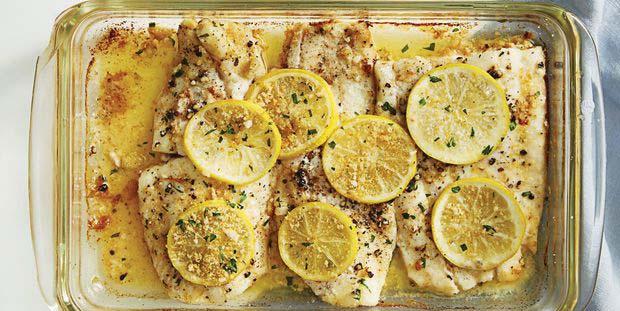
SCDNR LOGBOOK: SHARK TAGGING!




Opposite Page Top: Left - Graham and Bobby set the net, feeding it out across the bow. Center - Bryan uses a secchi disk to check turbidity, or visibility, of the water. Right - Bryan records data while Bobby preps the drumline.
Bottom: Left - Shark in the net! Center - Graham works quickly to untangle the shark. Right - Bryan measures the shark, which is already tagged.
Photos by Amy Thurman Background image provided by NOAA By Amy Thurman
On a hot summer day in late June, I rode along with Bryan Frazier, Bobby Edman and Graham Wagner, marine biologists with the South Carolina DNR Marine Resources Research Institute (MRRI), on a shark tagging expedition. Data collected is used to help give scientists more understanding of coastal shark species, including population abundances, lifespans, reproduction and a better understanding of their movements, among other information.
After a short ride from the SCDNR campus on James Island in Charleston, north to Bull’s Bay, we launched the 19-foot Privateer skiff at the Cape Romain National Wildlife Refuge. As I stepped aboard, moving around the nets and fl oats and other gear to fi nd an open spot to sit on the gunwale, I wondered how this was going to work. Four people and gear in a small space and we’re going to add a bunch of sharks to the mix? Let’s do this!
As we motored out, Bryan and I chatted about the uniqueness of Bull’s Bay. This inlet, which is part of the refuge, is one of the few on the east coast that isn’t fed by a freshwater river. It’s also very shallow. At high tide it appears to be a huge expanse of water, but at low tide, large areas of the bottom are exposed. (I later looked at it on Google Maps and switching from map view to satellite view shows just how shallow much of the bay is.) Were we really going to fi nd any sharks in ten feet of water? I was about to fi nd out.
We reached our fi rst net deployment location not long after leaving the dock. Unlike the shark tagging trip with the Georgia DNR last summer where baited hooks on a long line setup were used, on this trip a gill net would be used to bring sharks aboard the boat. This net is designed to target all species of shark, while avoiding most other species, such as red drum, trout and fl ounder. While I stayed out of the way and Bryan kept the boat steady, Bobby and Graham attached an anchor and buoy to one end of the 100-yard net, then began feeding it out over the bow. Floats were attached every 50 feet to keep the net vertical in the water and when the entire net was deployed another buoy and anchor were attached to keep it in place. This “set” would remain in place for 30 minutes before being hauled back in.
Next environmental data was taken for the set, including water temperature, dissolved oxygen, salinity and visibility, as well as air temperature, wind and cloud cover. We were surprised at the fi rst drop to discover that the salinity was 38.5 parts


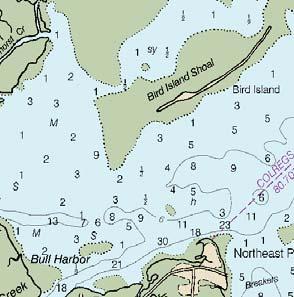

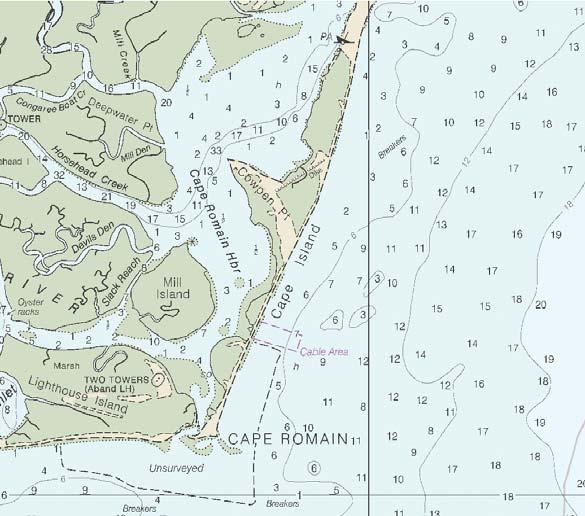
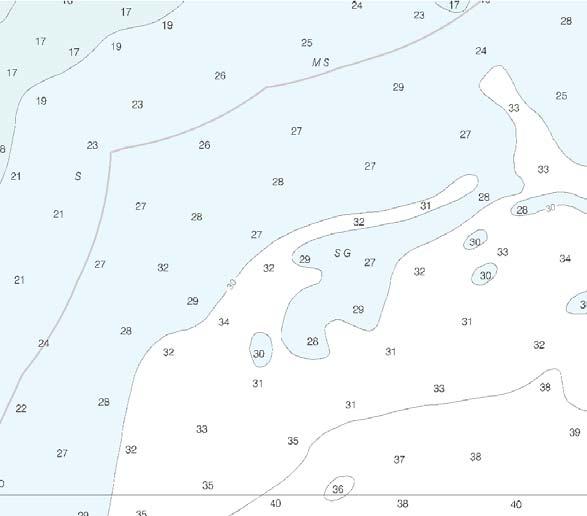
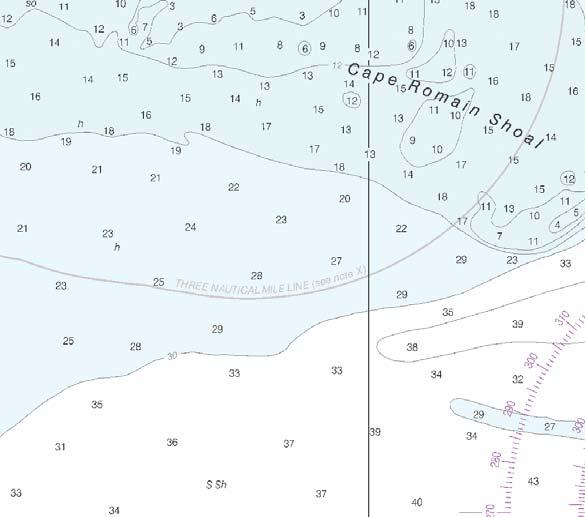
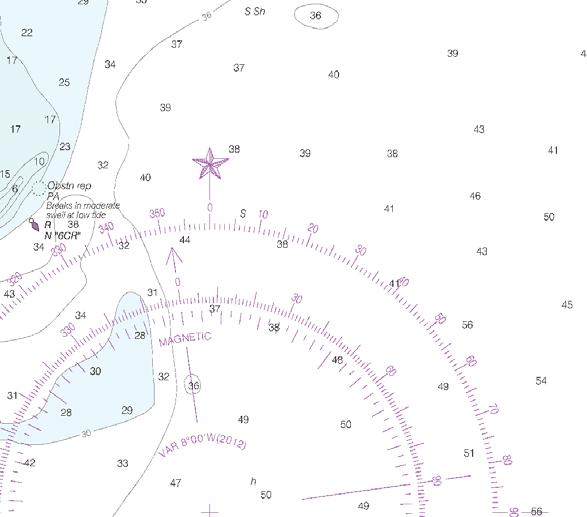
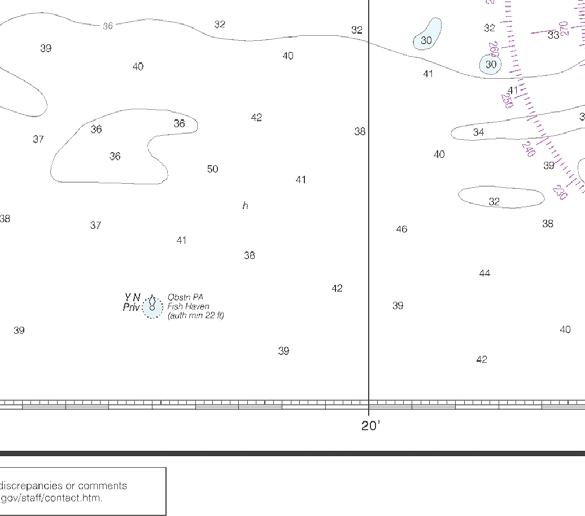

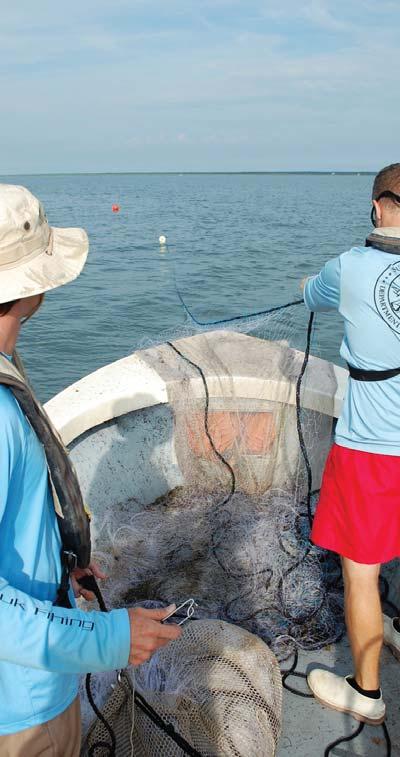
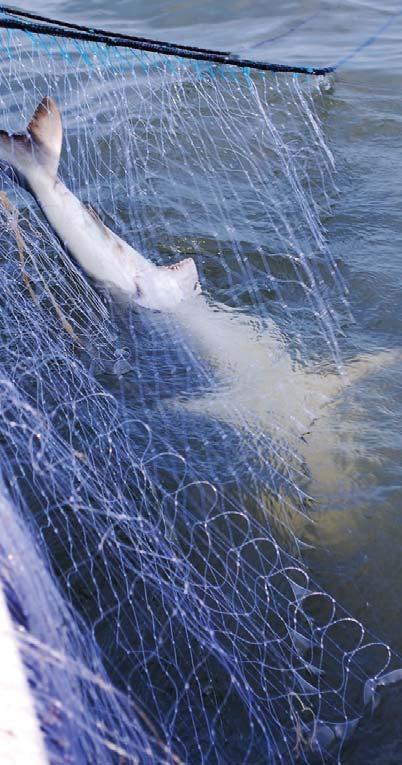
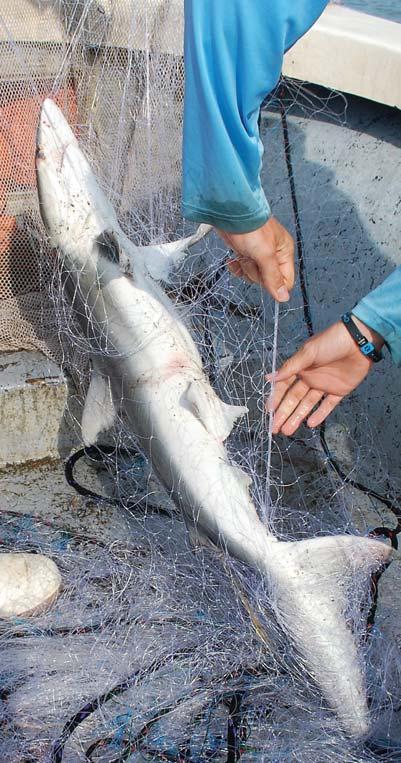
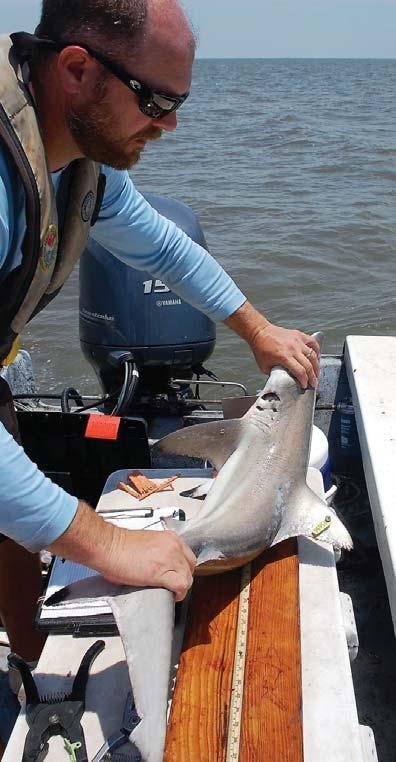
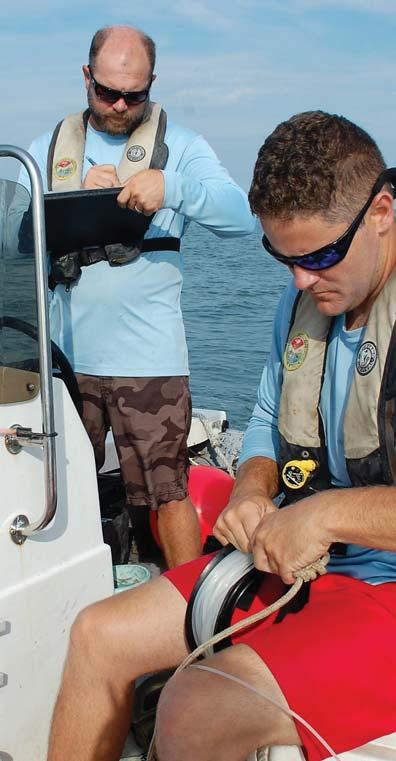
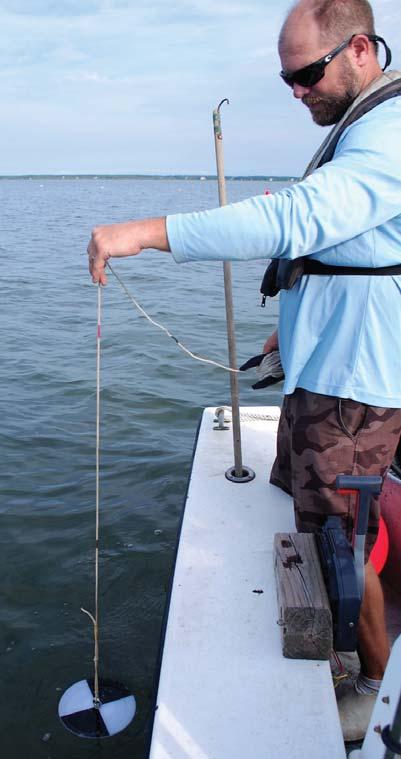
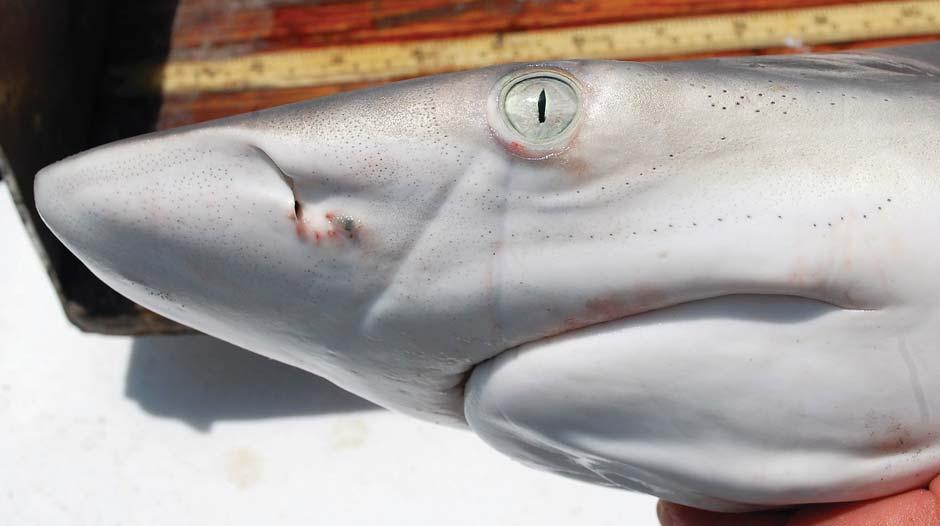

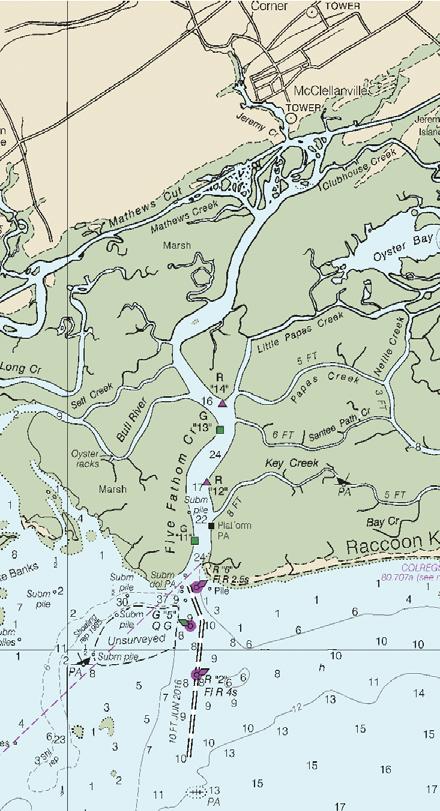

Left: Close-up of a sharpnose shark. The sharply-pointed nose and slender body can help tell it apart from other sharks. Mature sharks may have white spots on their bodies, as well. Sharpnose sharks reach about 3.5 feet at maturity. On this trip, the team caught 23 sharpnose sharks.
All photos by Amy Thurman Background image provided by NOAA
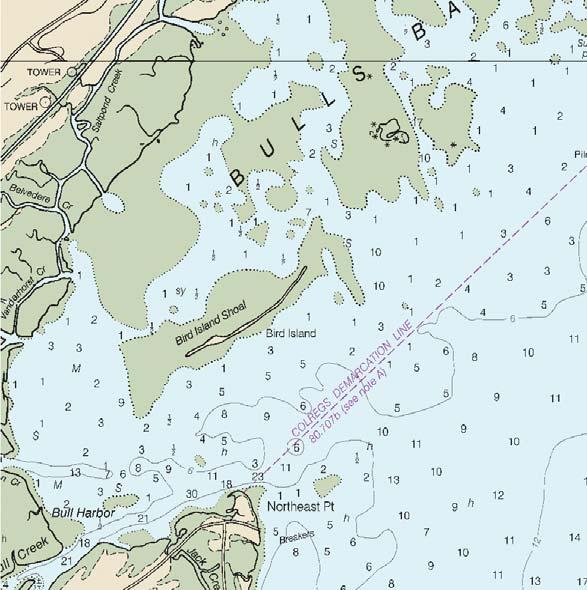
Right: The tail of a blacktip shark, next to my hand for reference. This species reachs six to seven feet at maturity. On this trip, the team caught 18 blacktip sharks.
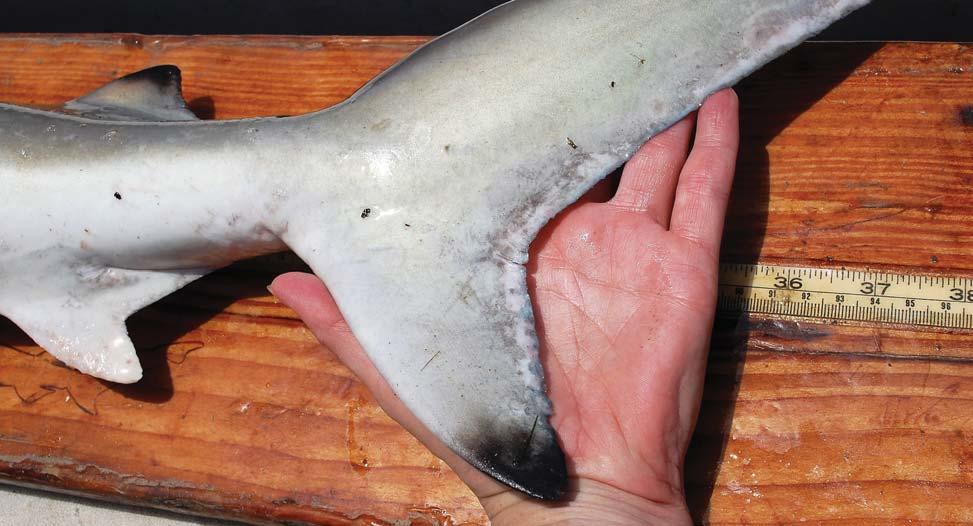
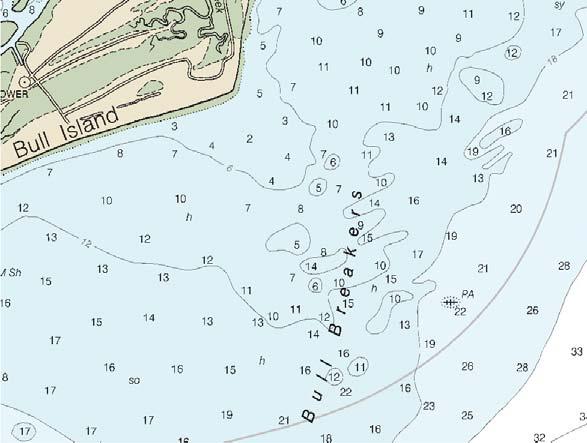
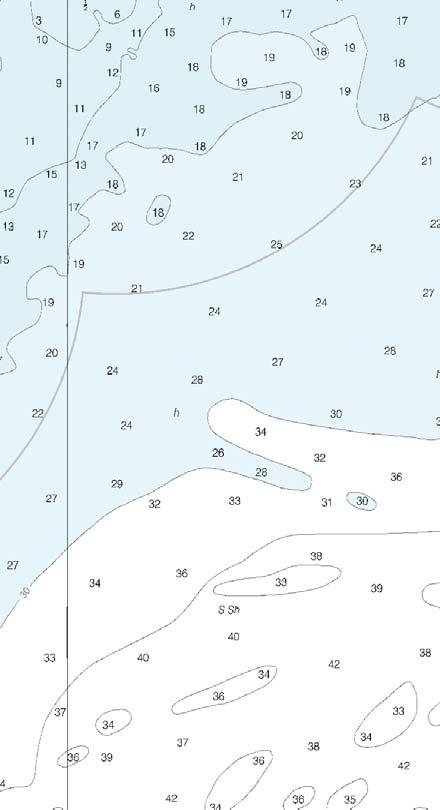
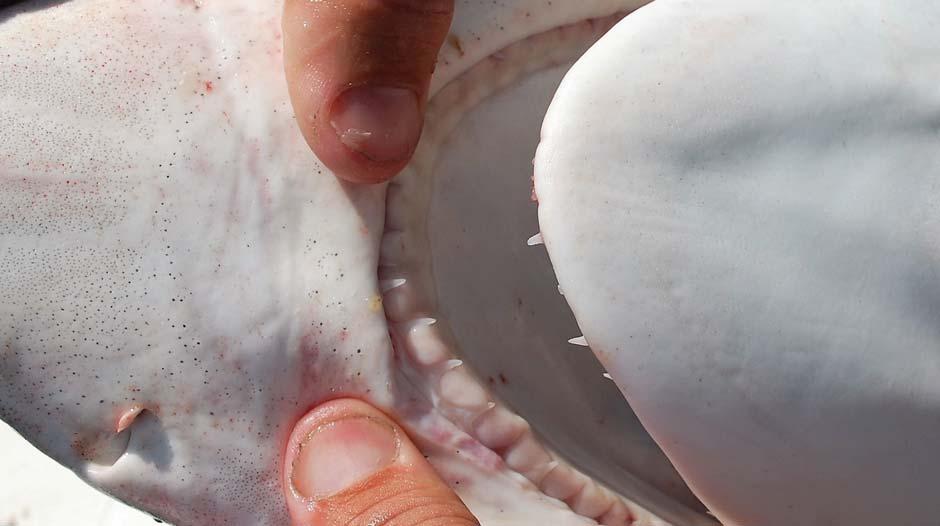
Left: Close-up of the teeth of a fi netooth shark. In addition to narrow teeth, these sharks are also distinguishable by their large gill slits. They can reach about 5.5 feet at maturity. On this trip, the team caught eight fi netooth sharks.




per thousand (ppt). Open ocean is typically around 33 to 35 ppt, while tidal creeks range between 22 and 27 ppt on average, so over 38 was high, possibly due to a lack of rain recently.
With time to wait until the fi rst net could be hauled, we moved to another location nearby, deployed the second set and recorded environmental data. Next a drum line was set. This was a group of six strands of heavy-gauge 600-pound-test fi shing line taped together to form an extra-heavy and durable line. A 20/0 circle hook was attached and baited with about a fi ve-pound piece of dead fi sh, then the rig was attached to a fl oat and played out. The purpose of this was to catch larger sharks that wouldn’t be caught up in the gill net.
By the time the drum line was in place, it was time to head back to the fi rst gill net set. We were all excited to see what we might haul up! Graham used a boat hook to snag the buoy and anchor, then he and Bobby each took one edge of the net and guided it back onto the boat in a neat pile. Almost immediately they hauled up a shark that looked to be four to fi ve feet long! They made quick work of untangling it from the net then handed it off to Bryan. This shark, a female fi netooth, was already tagged so he noted the tag number, measured her, noted her condition and the set location before releasing her back into the water. As soon as he fi nished, Graham handed him another, also a fi netooth, about the same size. This shark hadn’t been previously tagged, so after measuring and recording sex, size and condition, Bryan attached a numbered tag to the dorsal fi n with a device that resembled a pair of plyers.
Finetooth sharks are common in our coastal waters. Adults average about fi ve and a half feet long and can live for over 20 years. This species is unique in that their diet is made up almost entirely of menhaden, unlike other species that may feed on a variety of prey.
On the third set of the day we caught the fi rst sharpnose sharks, the most common species in coastal South Carolina and Georgia waters. Juvenile sharpnose are often confused with blacktip sharks due to the dark coloring on their fi ns; at maturity, they often have white spots on their bodies. They’re also the species most preyed on by other sharks.
“They’re the Rodney Dangerfi eld of sharks,” Bryan joked. “They get no respect.”
On the next set we caught the fi rst blacktip of the day. At maturity, these sharks average six to seven feet in length and are the most common large shark in our coastal waters (as opposed to sharpnose that only average about three and a half feet). In addition to the distinct dark coloration at the ends of their fi ns, this species also has “Z-line” stripes on its sides.
Later that morning the team was pleased to fi nd a blacknose shark in the net. Named for the dark smudge on the end of the rounded snout, this species is less common due to overfi shing. Blacknose sharks are more commonly found in nearshore waters and are somewhat rare inshore.
In one of the last sets of the day we pulled in a bonnethead. The unique shovel-shaped head of this shark is proof of the diversity in our natural world, but that isn’t the only feature that separates them from other species. Bonnetheads give birth, then mate in the fall but females store the sperm and don’t fertilize their eggs until the following spring. They also have the shortest gestation period of all sharks, carrying their young for only four and a half months.
As the day went on, the wind slowly picked up giving us a little break from the stillness earlier in the day. The tide turned as well and as we motored back toward the dock later that afternoon, large sandbars and vast expanses of mud fl ats were visible where previously there’d been water. Although the drumlines hadn’t been successful (but the stolen bait certainly made some unseen shark happy), the ten net sets generated good catches and data was recorded from 51 sharks. For more about our coastal shark species, see Did You Know? on page 13.
Many thanks to Bryan, Bobby, Graham, and Erin Weeks, as well as the SCDNR MRRI, for allowing Southern Tides to tag along!
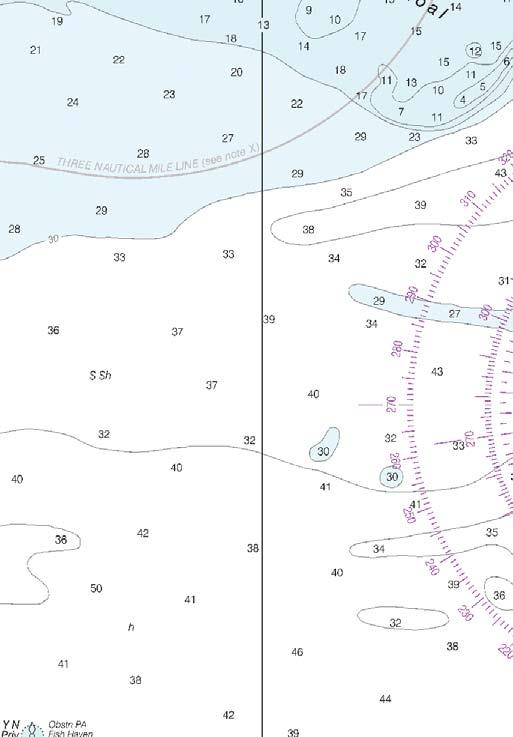

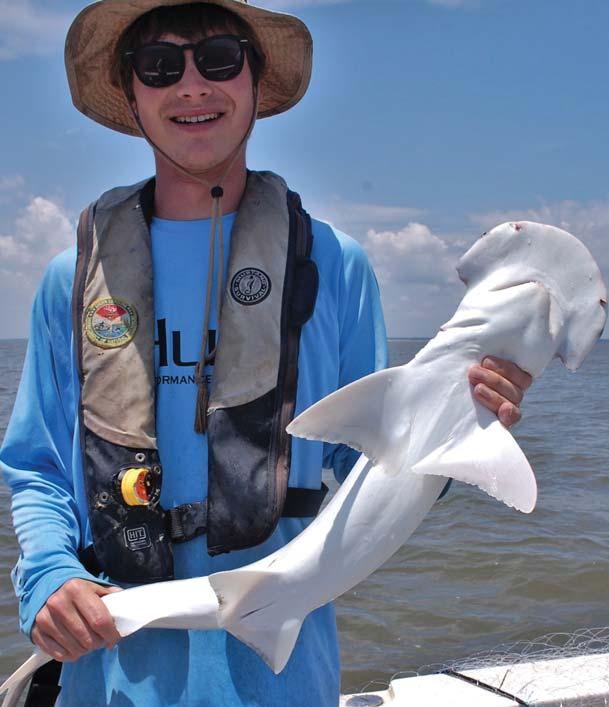
Graham showing off a bonnethead shark.
Close-up of a bonnethead. The shovel-shaped head makes it easy to distinguish from other shark species. These sharks typically reach three to four feet at maturity.
To report tagged sharks you capture, visit www.dnr.sc.gov/marine/tagfi sh/form.html. If possible, please provide the species, location, tag number, capture date, length and condition at release.
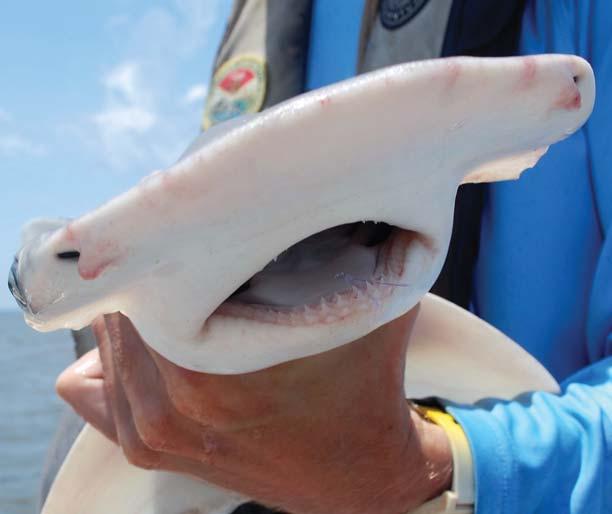
Call us. We’ll come get you!
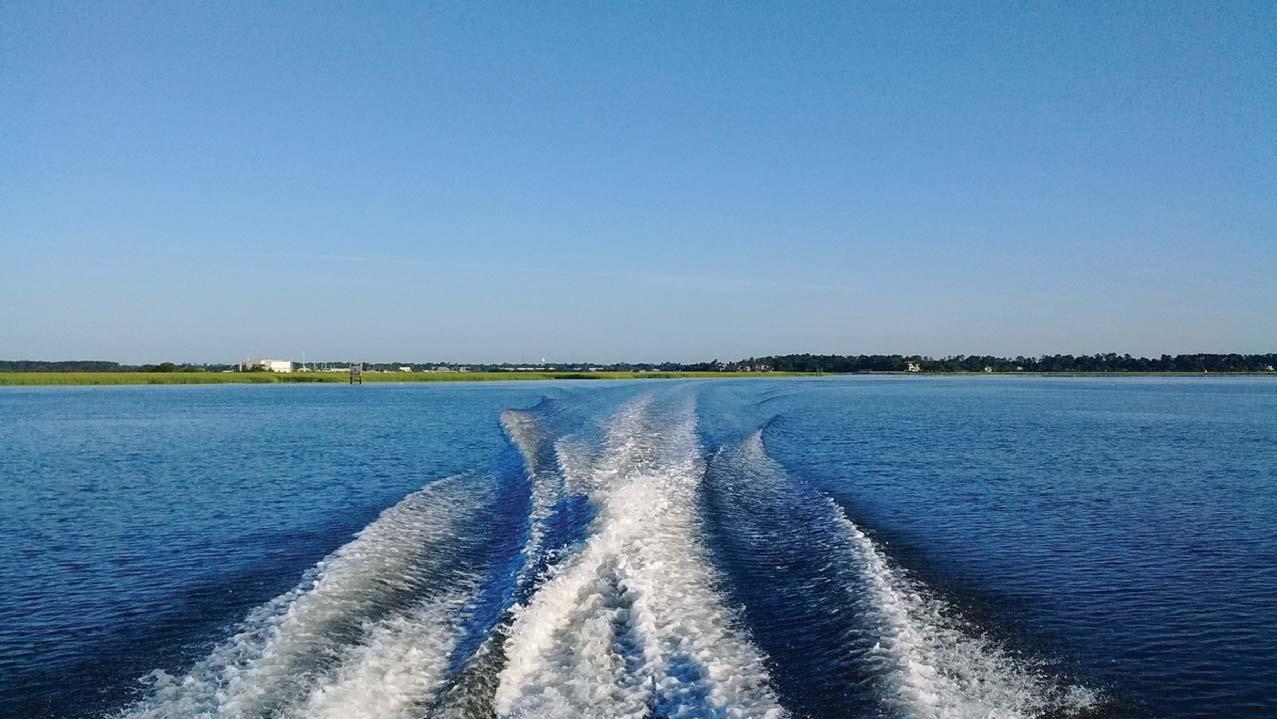
Serving Beaufort, Hilton Head, Savannah and St. Catherines Island
Service provides for ALL recreational boats you own, borrow or charter, anywhere in the world!
• Call your local tower for special signup discounts • Fast, experienced, and reliable service • BoatU.S. 24-hour dispatch services, call: 800-888-4869 • Towing service with ALL the benefits of membership in BoatU.S.
Towing • Soft Ungroundings Jump Starts • Fuel Delivery
For 24/7 Response, Call: 912-507-BOAT (2628)
$149 annual membership

